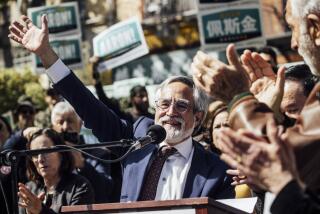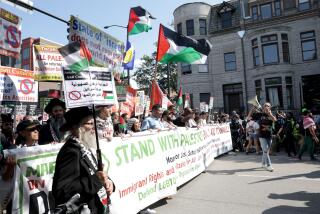For Better and Worse, Chicago Is Democratic Turf
CHICAGO â It is, beyond all quarrel or quibble, the largest urban bastion of the Democratic Party in America. The last Republican mayor was elected in 1927. Only once since the days of Franklin D. Roosevelt has a GOP presidential candidate carried Cook County: in 1956, when Chicago gave up on once-beaten Adlai E. Stevenson and concurred in the reelection of President Dwight D. Eisenhower.
Not content merely to vote Democratic, Chicago has lived Democratic. The New Deal, the Fair Deal, the New Frontier, the Great Society, ethnic politics, racial politics, liberal and reform politics, the City of the Big Shoulders has drained the Democratic cup to the lees.
And Wednesday, as President Clintonâs helicopter circled into an urban center whose architectural treasures gleam like a tiara, Chicago once more presents itself as âthe city that worksâ--a model for a national leader hoping to guide America into the 21st century.
Putting aside civic pride, is such a claim valid? When Bob Dole denounces the Democrats as champions of outmoded liberal nostrums and failed experiments in big-government social engineering, can Clinton point to Chicago in rebuttal?
The answer is that, while much has been achieved in the 28 years since the last Democratic convention to be held here ended in violence and political disintegration, Chicago remains a cautionary tale nonetheless.
Party Central
In achieving a level of political tranquillity and economic revitalization unmatched among the nationâs old industrial centers, Chicagoâs Democrats have built the kind of broad-based electoral coalition that has often eluded the party nationally. They have won significant commitments from business, forging partnerships that have allowed the city to claim progress against the problems common to all urban areas.
Moreover, Mayor Richard M. Daley has created a party structure that at some levels at least is more open and diverse than the one that existed under his father, who led the city in 1968.
âSaul Alinsky would have a hard time making a living here today,â says one business executive, referring to the pioneer of radical community organizing who was long based in Chicago. âItâs hard to get people worked up anymore because most of the leaders have access now.â
What is less clear is whether Democrats here have found the answers to other, deeper-rooted challenges, including:
* Reconciling the tensions that exist between the agendas of the partyâs old-line constituency groups on the one hand and the attitudes and interests of the larger society on the other.
* Finding a way to achieve the expanded opportunity in a competitive global economy that Republicans promise and, at the same time, advancing toward the kinder society that liberals see as the partyâs reason for being.
On such counts, the jury is still out. And the evidence comes in pieces large and small:
âFrom the 1980s, when large parts of the Loop were vacant except for roving gangs, there has been a tremendous change,â says University of Chicago urban affairs sociologist Gerald Suttles.
A Healthier City
On the other hand, when Bethel New Life, a church-related community organization, managed to create the first low-income condo building ever in West Garfield Park, the new sod on its modest front lawn was rolled up and stolen the night before the dedication ceremony.
âThe political performance is first rate. There is no question about that. . . . The governmental performance is another matter,â says Paul Kleppner, director of the Office of Social Policy Research at Northern Illinois University, who has studied the cityâs political history.
Without doubt, Chicago is healthier than it was during most of the last three decades--healthier, too, than Cleveland, Detroit, St. Louis or almost any other comparable city.
Though suburbs have grown explosively here as they have around almost every major U.S. city, fully 30% of all the jobs in the Chicago metropolitan area remain downtown. Through a selective concentration of police and other resources, the downtown is not only safer for office workers but also a major destination for upscale shoppers and for tourists, who flock to its refurbished museums and other attractions.
Even before it won this yearâs Democratic National Convention, Chicago had begun to bring its once-matchless system of parks back to life, including long-neglected green spaces in the predominantly poor, minority neighborhoods of the south and west sides.
Older prime residential areas have been preserved, especially the affluent neighborhoods along the Lake Michigan shore. Large housing projects have been added for young professionals and other downtown workers.
In the poor neighborhoods, a new library can be found here, a new playground or health clinic or senior center there. Everywhere, clumps of new and rehabilitated homes and apartments are being built for working people as well as the very poor--often as a result of partnerships among city and federal agencies, private corporations and community groups.
A start has been made as well on closing the notorious high-rise public housing projects.
âIf you look at the last 10 years, the abandonment of the inner city has slowed down,â says John F. McDonald, an economist at the University of Illinois-Chicago. âThe abandonment of neighborhoods took place in the â70s and â80s. . . . The city lost a lot during those years, but that loss has slowed down.â
At the same time, Democrats here have begun learning to live with a diminishing stream of federal dollars. For one thing, community-based, often nonprofit organizations now deliver services that would once have been the fiercely guarded prerogatives of city bureaucrats and patronage workers.
Those are some of the pluses.
There are minuses, however, and they raise questions about whether Chicago has quite finished the job of perfecting a model for the nation.
Most basically, the cancerous core problems of urban America have been slowed but not eradicated.
Crime, drugs and gang violence continue to devastate the south and west sides. Vast areas of the city--industrial districts as well as poor neighborhoods--look like theyâd been neutron-bombed. Thousands of buildings stand empty, contributing to an eerie peacefulness but decimating the tax base. The city raises only 70% of its annual budget, depending on state and federal aid for the rest.
The outflow of jobs and middle-class residents continues, though more slowly.
Racial divisions remain deep and the social and political peace is sometimes peace without joy or enthusiasm. Though Daleyâs inner circle is small and virtually all white, a recent study found that working-class African American areas were happier with Daley and the way the city was being run than were white ethnic neighborhoods.
Finally, for all the rhetoric, much remains to be done to make Chicago economically competitive. Remnants of the old ways of doing things still impose higher costs and lower productivity on the city than many of its competitors.
The mayor has continued his fatherâs emphasis on retaining businesses, especially major corporations headquartered downtown. But it is unclear whether that extends to knocking heads with labor unions that have always played a central role in Democratic politics.
The city, for example, is spending lavishly on up-to-date convention facilities. But some exhibitors complain that union wages and rules make it harder and more costly to come here than to some other cities.
A six-pack of beer delivered to an exhibitor at McCormick Place, the cityâs huge lakefront convention facility, can cost $60, according to one Chicago business leader--â$5 for the beer and $55 for labor,â he said with a laugh.
Soaring Taxes
And the continuing erosion of manufacturing jobs tells its own tale:
Daniel B. Shure is president and CEO of Strombecker Corp., a leading toy manufacturer that created Tootsietoy model cars and the original lead flatiron and other objects used in the first Monopoly games. Shure struggles to keep his aging Chicago plants running.
But his frustrations are manifold:
Taxes here are twice as high as on his plant in New York state. The sales tax here is 8.75% while his Oklahoma plant pays none. Workersâ cars are vandalized. Gangs and drug dealers on surrounding street corners are so intimidating that prospective workers sometimes refuse to stop for interviews.
As for government, says Shure with exasperation, empowerment zones, tax breaks and other new programs for helping companies bring new plants to poor areas would make it profitable for Strombecker to shut down its old plants and move elsewhere.
âWeâre penalized for staying,â he declares.
More to Read
Get the L.A. Times Politics newsletter
Deeply reported insights into legislation, politics and policy from Sacramento, Washington and beyond. In your inbox three times per week.
You may occasionally receive promotional content from the Los Angeles Times.










